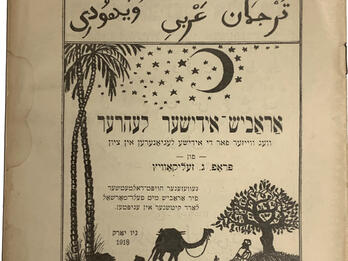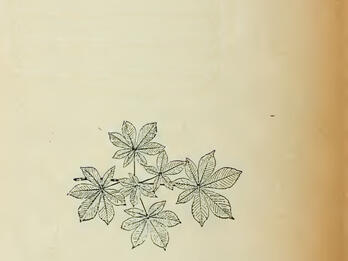Specific Hebrew Pedagogical Problems
The Jewish kindergarten not only needs to be, but also can be in Hebrew. But at the same time, we must recognize that in the countries of exile, this matter entails arduous labor. If we saw the kindergarten as no more than a factory for Hebrew speech, then the work would not be extremely difficult. It is possible to teach the child to speak [Hebrew] within a few months. But the kindergarten is, after all, the first and most fundamental institution for both human and Jewish education, which comes to us packaged in Hebrew—our national language. And this is sufficient reason to expand upon the kindergarten issue for us. The kindergarten seeks to discover and develop the child’s innate creative forces as a future person. Creativity can be found not only in literature, but also in life, and the mission of the kindergarten is to nurture full-fledged creators of life. [ . . . ]
We find a serious dearth among us of true poetical works for our children. They live without poetry and without true beauty; and while we may already have some fine literary treasures, these things are not yet appropriate for the child and acceptable to his heart. The key to children’s hearts is very different from that to our own. In the recent past we had an excellent creator of children’s poems—namely the old mother—“Grandma” [ha-savta]. She and she alone understood the soul of the child who thirstily drank her [Yiddish] songs: “Unter Yidele’s vigele,”1 etc. The literary giants have attempted to translate these songs [in Hebrew], but without success . . . [ . . . ]
Speaking of the structure and the plan of the kindergarten, the lecturer showed the need to make the kindergarten an institution for the folk. We should adopt and develop the lingering traditions in the parents’ house; we should translate the classical works of the European peoples; we should bring the Hebrew past and present into the kindergarten. This is acknowledged by the finest pedagogues in the world.
And the kindergarten should develop the child’s innate strengths and push them toward creativity. This idea was developed by Friedrich Fröbel.2 This awakening is extremely important at the age of two and a half to three years—the period of discovery and expression that follows the acquisition of physical capabilities: i.e., speech, imitation, and dancing that emerge in the child due to his need of self-discovery. A child who comes to the synagogue and sees his father wrapping himself in the prayer shawl feels compelled to imitate him; when he hears a fine story that captivates his heart, he feels compelled to draw it or otherwise recreate it with his own strengths. . . . And if this takes place, we secure our educational goal. In school our point of departure is the studied object; in the kindergarten it is the essence of the child. In school we have a general and shared object; in the kindergarten, we have only the child’s soul. The center of gravity in kindergarten education is individual education. Teach the youth according to his way (Proverbs 22:6). And if we are unable to meet this demand we will have to accept only children from one [socioeconomic] class and one neighborhood.
Accordingly, the (female) kindergarten educator should not teach, but should expand the creativity of the child. And if we accept all these assumptions, we will immediately see all of the many difficulties in our kindergarten. The [educational] environment of the home is different from that of the kindergarten. The language of the latter has no connection with the language of the home. Furthermore, the national [i.e., Hebraic] tradition is absent in the [Jewish] home, and accordingly we cannot find harmony and unity between the two worlds of the child: the home and the kindergarten. [ . . . ]
The lecturer then proceeded to speak of [his envisioned training] institution for (female) kindergarten teachers. This institution must be built on the basis of the kindergarten curriculum, since the kindergarten teacher is a friend of the children. The (female) kindergarten teacher must be given proper preparation in kindergarten pedagogy and methodology. Apart from the great importance of this matter—in our case the kindergarten is still a virgin land—each (female) kindergarten teacher is akin to a “creator ex nihilo.” The male schoolteacher finds everything ready before him, but this is not the case with the female kindergarten teacher. In order to create one word for the child, she must be thoroughly saturated with the ancient and new literature; she must be familiar with the treasures of the agadah in order to use them to feed the children’s souls; and it hardly needs to be stressed that she must be well-versed in general (i.e., secular) matters. Accordingly, the lecturer proposed extending the period of studies from three years to four; despite the great demand for (female) kindergarten teachers, it is impossible to rush, thus preparing incapable and unqualified kindergarten teachers. The responsibility is enormous.
Notes
[Heilprin here refers to a widespread Yiddish folk song “Unter yankele’s vigele” which became still more famous when the pioneering Yiddish playwright Abraham Goldfaden incorporated the song as the refrain of his song “Rozhinkes mit mandlen” in his 1880 operetta Shulamis; Goldfaden changed the name Yankele to Yidele in the process.—Eds.]
[ Fröbel (1782–1852), a German educational pedagogue, often recognized as the “father” of the modern kindergarten.—Eds.]
Credits
Yeḥiel Halperin, “Hartsa’ato shel Y. Heilprin” [Specific Hebrew Pedagogical Problems: Jewish Educational Curriculum and Teacher Training], Ha-‘am 26, no. 5 (July 16, 1917): pp. 20–21.
Published in: The Posen Library of Jewish Culture and Civilization, vol. 7.




